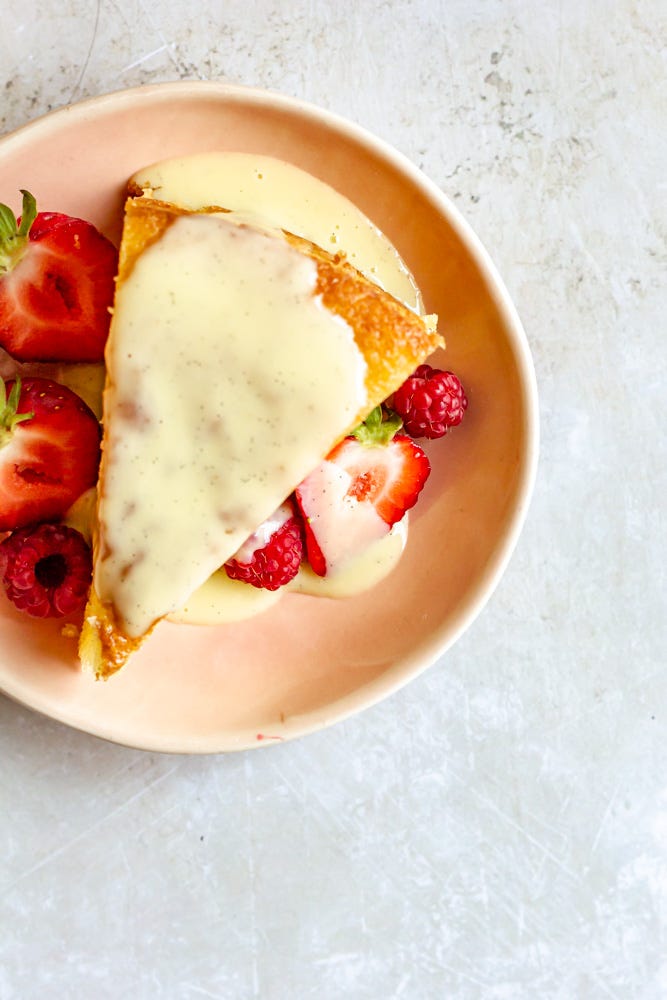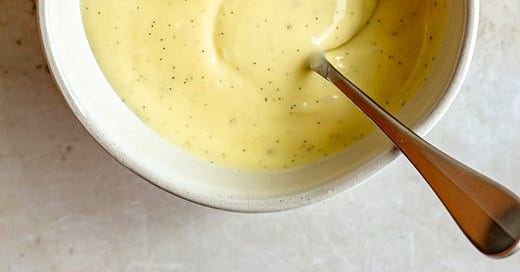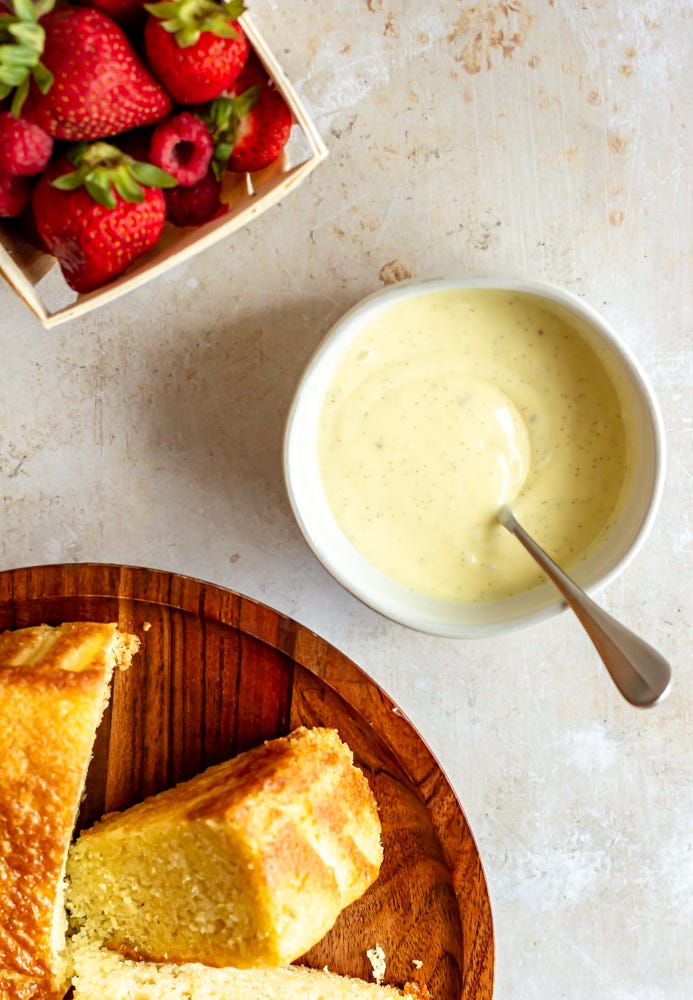Hi! Happy July! I hope that your summer thus far has been filled with sunny days, good books, and lots of lake/beach/pool days. And ice cream. A lot of ice cream.
We’re continuing right along in our cooked custard saga with crème anglaise. It’s a silky, smooth custard that is used for many things—most importantly as our beloved ice cream base. This month, you’ll find a recipe for basic vanilla bean anglaise sauce (at the end of this newsletter) plus there are two brand new ice cream recipes coming your way in the next few weeks. I just can’t wait, so let’s jump in!
so what is crème anglaise
I vividly remember my first introduction with crème anglaise, though I didn’t know what it was at the time. As a kid living in the Sunshine State, we spent a fair amount of time at Disney World, and our favorite in-park meal was the Octoberfest-themed German buffet nestled in the back of the Epcot World Showcase. There were brats and sauerkraut, schnitzel and kugel, polka music and mid-dinner dancing, and best of all, apple strudels with a vat of vanilla crème anglaise. And since it was a buffet, there was as much anglaise as you wanted—a real dream come true.
Crème anglaise (or “English cream” in French) is a custard-style cream sauce used for all sorts of dessert applications—like drizzling over apple strudel or cake or even just a bowl of fresh berries. It, like pastry cream, falls into the big pastry category of cooked custards. There are two main, easy to remember differences between crème anglaise and pastry cream: starch and boiling. The methodology and most of the ingredients are the same, except pastry cream incorporates flour or cornstarch and therefore needs to be boiled. This results in a much, much thicker custard.
Crème anglaise on the other hand, is thickened only with egg yolks resulting in a thinner, silkier, more pourable sauce.
how to make crème anglaise
The process for crème anglaise should be familiar, as it is the same as most cooked custards.
Start by heating heavy cream to a simmer. You can definitely steep all sorts of flavor into the cream ahead of time. Just combine cream and your flavor enhancer, bring to a simmer, then remove from heat and let steep covered for about 30 minutes before removing your flavor enhancer and re-simmering.
While the cream is heating, whisk together sugar and egg yolks to form a paste.
Slowly temper the hot cream into the egg yolks until combined and then transfer the mixture back to the pot.
Cook over medium-low heat, stirring continually with a wooden spoon until the sauce thickens. Strain and chill, either in the refrigerator or by setting the bowl of custard in an ice bath.
a quick note on how to tell if your crème anglaise is done
Because crème anglaise doesn’t come to a boil, we have to use other senses to tell when it’s done. The temperature you’re aiming for is about 180° F, so you can use a thermometer if desired, but I prefer to use the nappé method.
Nappé is the French term for when the sauce coats the back of a spoon in a thin layer. For crème anglaise, I test this using a wooden spoon. When I can tell that the sauce is beginning to thicken, I begin testing it by lifting the wooden spoon out of the custard and dragging my finger in a horizontal line across the spoon. Looking at the top line of custard left by my finger, if the custard stays in place the sauce is done. If the custard drips, continue cooking until it stays in place.
I tried to take a picture of this and found it very challenging to do one handed in overhead kitchen lighting, but I googled and found a few pictures that might help you visualize it.

a basic vanilla bean crème anglaise recipe
makes one cup of crème anglaise
Ingredients:
1 cup (230 g) heavy cream
1 vanilla bean
75 g (1/3 cup) granulated sugar
2 egg yolks
pinch of salt
Procedure:
Slice the vanilla bean open and scrape out the inside. Place the vanilla bean paste from the inside into a large bowl and put the empty pod into a medium saucepan with the heavy cream.
Bring the cream to a simmer and then remove it from the heat. Cover and let steep for about 30 minutes before discarding the vanilla bean pod.
Bring the steeped cream back to a simmer.
While the cream is heating, add the sugar, egg yolks, and pinch of salt to the bowl with the vanilla bean paste. Whisk to combine.
Carefully stream the hot cream into the egg/sugar mixture, whisking continually. When all of the cream has been added, transfer the entire mixture back to the saucepan.
Cook over medium heat, stirring continually with a wooden spoon, until the sauce has thickened.
Strain the crème anglaise through a sieve and press a piece of plastic wrap directly on the surface. Chill in the refrigerator until cold.






Omg I’ve been scouring Substack for deep dive culinary writers! So glad to have stumbled upon this, can’t wait to read your work!